Maintenance and Products for Victorian Hearth tiles
Encaustic cement tiles
How to clean Encaustic tiles?
The NATURAL FLOOR cement tile Is very easy to maintain.
Mopping the floor with neutral ph soaps will maintain the colours at their best for decades. Ocasionally, normal mopping wax can be added to the water.
How to treat Encaustic tiles?
Glossy, Wet effect
To waterproof and protect your Victorian tiles, you can apply a waterproofing product that is typically used for outdoor natural stone or terracota tiles. We offer two different finishes:
WET EFFECT PROTECTOR. This will seal the tile to protect it from liquids and mold, giving it a mirror finish.
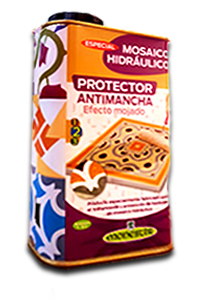
1L container
Treatment for 8 - 12 m2
Treat the floor and revive the colors with a wet effect and a satin finish: Special for places of high traffic or with a higher risk for stains. With a perfectly dry and clean floor, apply a well-stretched and uniform hand using a sponge roller or broad brush. After 4 hours we can apply a second hand (recommended). The result is more intense and has a much greater protection.
Matte effect protector
The Matte protector will leave the tiles with their original matte finish. (tiles will obtain their natural satin effect over time) This Matte protector will protect against stains and mold.
TRANSPARENT ANTI-STAIN PROTECTORR. This will seal the tile to protect it from liquids and mold, leaving the natural effect of the tile.
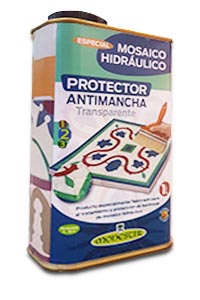
1L container
Treatment for 8 - 12 m2
If we want to treat the floor maintaining the natural tonality and also protect against atmospheric inclemency outdoors, against the outflow of saline efflorescence and against domestic stains. Anti-ice effect.
With a perfectly clean and dry floor, apply a well-stretched and uniform hand with a sponge roller or broad brush. It is advisable to apply a second coat after at least 4 hours to achieve a better stain protection.
Ecologic liquid wax
Wax has been used for centuries, we recommend using the more specific treatments that are available today, But if you would like that wax effect or some extra protection, this wax can be used on top of other waterproofing products.
ECO WAX. This will give some extra shine and protection to the tiles.
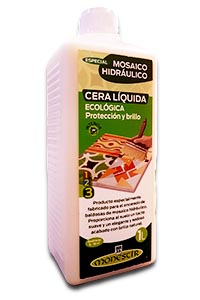
1L container
Treatment for 8 - 12 m2
Can be used with both the transparent treatment and with the wet effect, if we want to obtain a more intense and uniform shine and leave the floor much softer to facilitate ordinary maintenance, we can apply LIQUID WAX.
How to fix damaged encaustic tiles?
There are several products that can be used to fix damaged tiles depending on the type of damage. Read on for more information.
How to remove stains from encaustic tiles?
Grease and other stains
Can often be removed with washing- up liquid, but for more permanent damage, we recommend using:
DEGREASER, STAIN REMOVER and STRIPPER which is a very mild abbrasive liquid.
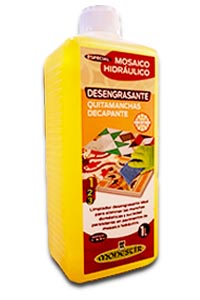
1L container
Treatment for 8 - 12 m2
Dilute 1 part of product with 5 parts of water and apply with a mop on the dry floor. Let act for a few minutes, rub with scouring pad or rotating machine and rinse with mop or vacuum cleaner.
How to remove cement and grout remains from encaustic tiles?
Cement, paint, grout or carpet glue
If you haven't been able to clean all of the installation remains, the quickest and most effective way to do so, is using our:
CEMENT and GROUT REMOVER which is a slightly more acidic abbrasive liquid.
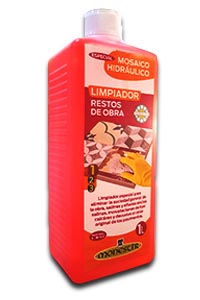
1L container
Treatment for 8 - 12 m2
To clean cement and other work remains: cement and saline efflorescence. Dilute 1 part of product with 5 parts of water and mop it on the dry floor. Rub with scourer, root brush or rotating machine and rinse with mop, sponge or vacuum cleaner.
How to restore antique encaustic tiles flooring?
If none of the above solutions work on a very damaged floor, not all is lost: A cement tiles mosaic with some broken areas can be restored without the need to change the whole floor. For this; one of the broken pieces is needed to reproduce the old colour and texture (if any) so it won't stand out once it's placed along with the old pieces. We can make the exact design and colours, and only those few pieces you may need.
How to install encaustic tiles?
Victorian hearth tiles are easy to install and can be used on many different surfaces thanks to its concrete base.
Placement may carry out any professional tiler following these basic guidelines:
Encaustic cement tiles can be placed with the adherent of your choice depending on the surface (see below).
The most convinient way to tile is using double-spread, both on surface and tile.
The surface where the tiles are to be places must be completely flat, if it isn't breakage could occur in the future.
Because tiles are hand made, tiles must be leveled manually. They do not need expansion space as they don't dilate in hot or cold weather.
To apply the grout, it's best that the tiles are wet, and the surface is wiped immediately with a wet cloth (grouting about 1 m2 at a time). Tiles are very porous at this stage so we need to take special care to keep them clean.
Once the tiling is done, The floor must be thoroughly scrubbed using mild soaps and left to dry.
The desired sealer treatment can now be applied. It is up to the customer to choose the treatment that provides the desired effect and end result. This treatment is done once and can be repeated every couple of years if necessary.
It's important tiles are not pre-treated, becuase even if the initial result looks good, in time this can cause moisture to get trapped on the surface of the tile resulting in stains.
What adhesives are used on Encaustic tiles?
Depending on the surface, different adhesives can be used to install the Victorian tiles.
An existing floor
When laying tiles over an existing floor, the floor must be completely level, solid and securely fixed to the substrate beneath it. (this is only recommended on floors)
The best product for this would be latex modified cement glue.
A new concrete surface
Normal cement glue or mortar can be used for this type of surface, like any other tile.
Wooden surface or tiles.
For wooden surfaces and tiles, the best option would be silicone.
